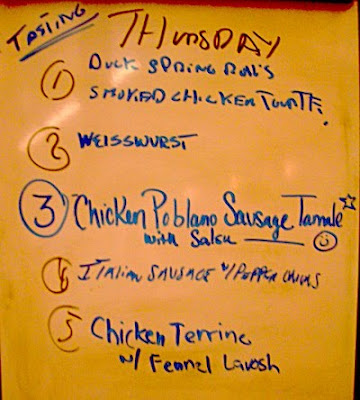
As we gathered ingredients for our Culinary Arts class last Wednesday, we discovered a cart with delicious-looking cured meats and sausages drying in our walk-in refrigerator. This is how we learned that Chef Lars Kronmark’s charcuterie workshop is happening in the mornings of the same week and in the same kitchen as our afternoon class.

The next day I came to school in the morning to take a peek at the charcuterie magic. Then I collected all my courage, walked up to the chef instructor, introduced myself, and asked permission to observe the class and take pictures. Chef Lars kindly invited me to the class, answered my questions, and after learning about my background he actually asked me more questions about pork and charcuterie traditions of Russia than I asked him about the recipes and the techniques. I got to watch chef Lars pick a cooked pig's head for headcheese, to talk to participants, watch them unmold the pates, roast the sausages, take the salmon out of the smoker, prepare the sides, help with de-boning a smoked chicken and some clean-up, taste everything, and I got invited to lunch!

The fourteen chefs who participate in the workshop come for this one week from all over the country, and I was surprised to find out that the majority of the chefs work in hotels, country clubs, and golf clubs, traditionally “steak and potato” places known for very conservative food. So, charcuterie is not a new trend anymore, it’s mainstream.



Lessons learned:
- Duck rillettes made with pork fat can be molded and sliced just like a pate; duck fat would just melt at room temperature
- They use a Bradley smoker for both hot smoking (charcoals inside) and cold smoking (charcoals in the outside box) – not at the same time
- The neat-looking pate press, a wooden box with screws to push down the lid, can create a terrible mess if you apply too much pressure; the juices fountain all over the kitchen
- Our temperamental Viking ovens work just fine for these professional chefs who roast sausages in them with no problems
- Hot smoked salmon is very difficult to slice, even for people with excellent knife skills

After the lunch and a walk in the CIA’s herb garden, it was time to go to our class. The topics were Braising, Stewing, and the cuisine of Mexico.
The main trait of the Mexican national character seems to be the love of hard work. Mole is a proof. Making Rick Bayless’s Simple Red Mole took three hours of three people continuously roasting, grinding, hydrating, reducing, mixing, hydrating and reducing the ingredients again. Did I mention 26 ingredients?
We got so absorbed into creating the mole that we missed the desserts!

The menu was:
Tortillas
Roasted Serrano salsa
Tomato, potato, and avocado uncooked table salsa
Spicy mushroom tamales
Juchitan-style black bean tamales
Smoky peanut mole with quail
Simple red mole enchiladas with braised chicken

 While shopping for duck legs, pork belly, live spot prawns, and other exotic things in Ranch 99 oriental market we came across something that looked like a beautiful tropical flower, and was just $1.89 a pound. The name is "Dragon fruit". We asked a few store clerks and oriental-looking customers, and no one knew what it is and how to eat it. So we just took the beast home with us.
While shopping for duck legs, pork belly, live spot prawns, and other exotic things in Ranch 99 oriental market we came across something that looked like a beautiful tropical flower, and was just $1.89 a pound. The name is "Dragon fruit". We asked a few store clerks and oriental-looking customers, and no one knew what it is and how to eat it. So we just took the beast home with us. An Internet search identified it as a fruit of a cactus plant, to be peeled, sliced, and eaten raw. The white flesh dotted with black eadible seeds is fresh and juicy, and the texture and taste remind me of an underripe supermarket strawberry, just a different color. Unexciting, considering the appearance of the fruit.
An Internet search identified it as a fruit of a cactus plant, to be peeled, sliced, and eaten raw. The white flesh dotted with black eadible seeds is fresh and juicy, and the texture and taste remind me of an underripe supermarket strawberry, just a different color. Unexciting, considering the appearance of the fruit. Next time, I'll sure buy it, and use it whole for table decoration.
Next time, I'll sure buy it, and use it whole for table decoration.















































